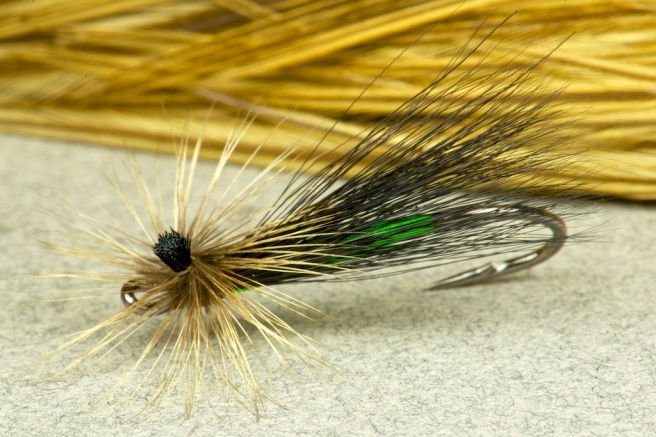It’s not often that a fly pattern makes such a huge impression on me – but this unlikely looking bug (at least to European eyes) has done just that. And I apologise to my Canadian and North American friends who will be yawning just about now.
While classed as an important group of patterns in the Maritimes, Im pretty sure that over here in a world of Shrimp Flies and Tubes of all shapes and sizes, this style on it’s unassuming single hook and unconventional looks has gone pretty much unnoticed by many. Though I have heard rumours about this fly scoring on a certain Scottish river.
First designed and introduced by Lee Wulff, this pattern offers a very different silhouette than any other salmon fly and is designed to be swung high in the surface. The original used a melted plastic body that was used to seal in and trap the hackle. The picture below is of an original Lee Wulff Surface Stonefly pattern from the early 80’s and shared courtesy of a friend of mine Per Stadigh. It illustrates just how much the original has changed over the years.
There are a whole assortment of variations out there, some with flash, some with foam bodies, different coloured hackles etc. The common component between most of them being the method of attachment of the hackle. In most cases this being a bent pin with a retaining bead, though I have seen examples using a heavy Mono or Fluorocarbon post with a melted end to retain the hackle.
Bright Fluro Green body with a black wing seems to be the common theme though there are versions with white over wings etc. Hackles I’ve seen vary from grizzle to badger in all sorts of qualities.
The version I’m going to describe is called the Paul Carron Stonefly and is based on examples I’ve fished with and conversations with David Bishop, President of the Gaspe Fly Company who introduced me to the pattern and manufactures the fly commercially.
Dressing
Hook- Lightweight single hook, here I’ve used a Partridge N.
Body- Fluorescent green floss, built up to a cigar taper and strengthened with a coat of “Hard as Nails” which also tends to deepen and hold the colour.
Wing- The original used dyed black bucktail taken from the centre part of the tail that would be brown on a natural tail. This hair tends to flare less and is more manageable. The wing on the original was mounted to flare flat over the top of the shank rather “than tied in the round” like a standard hair wing. I guess to provide more support on the surface action on the swing. In this case Ive used black squirrel.
Hackle post- The butts of the winging hair are posted. Im sure this is an important variation as its lighter in weight than the pin and bead method. And just as secure it seems.
Hackle- On the examples I’ve seen they have all used Silver or Blond Badger. Personally Im not sure of the importance of this and as you can see I’ve used a Dirty Badger, as it was the only similar hackle I had to hand in the correct quality and size.
As a note on hackle, although I didn’t discuss it, all the examples I saw used excellent quality, stiff and sharp hackles, similar to those you would use on dry flies.
Paul Caron Stonefly (slight variation)
It’s important to attach this fly in-line with the tippet to keep it tracking in the correct attitude, a double turle knot being perfect for the job. Apart from that, as far as I can see, its fished down and across just like any other wet fly (though Ive heard mention of greasing it and fishing it dry, maybe thats why the hackle quality is there?) Depending on the weight of the current, it seems to either fish just subsurface or is very visible tracking in the surface. Not unlike a hitched tube but less pronounced. More subtle perhaps.
The takes are very visual and heart stopping, explosive in the surface with fish boiling at the fly. On several occasions recently, I’ve experienced a fish coming to this fly repeatedly before finally hitting it hard. Wonderful fun!
When we finally get some water I’m going to give this fly a serious tryout on my local river (the Usk, in South Wales) Im really looking forward to that and I have all sorts of variations floating around in my head that I’m going to try on the Towy for Sea Trout this summer.
Mainly I’m thinking black and silver with a little flash (well I would, wouldn’t I) – Its just got to work!!
Paul Slaney
I should give this up, wrapping bits of fluff on a hook for fun just can’t be normal.



























